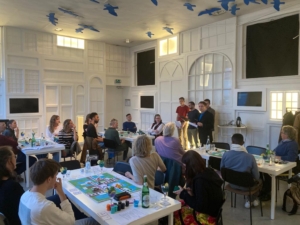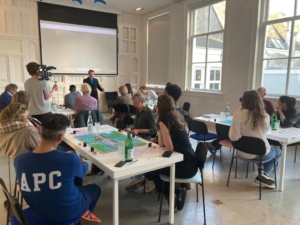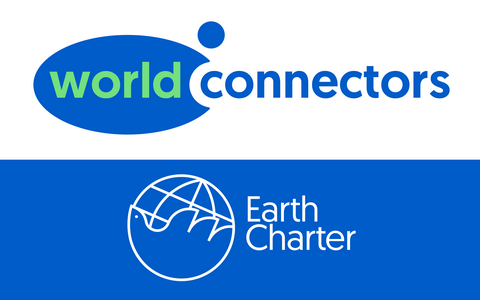Dialogue Power to the Planet
On Tuesday, May 16, Worldconnectors, in collaboration with Studio Zeitgeist, organized the Power to the Planet dialogue. This evening was intended to serve as both a follow-up to the Power to the Planet project, the launch and trial of the board game with the same name and a stepping stone for generating new ideas for innovative actions to work on together.
Starting from 6:30, participants gathered at the design temple @droog in the heart of Amsterdam to enjoy a delightful meal together. During this dinner, the rules for the board game were distributed in preparation for what was to come.
Around 8:00, it was time for the participants to take their seats at one of the four tables where the Power to the Planet board game was set up. After a brief introduction by Rindert de Groot, the evening’s moderator and the brain behind the board game, several questions were posed to the participants to determine what the world of the game would look like.
First, Rindert inquired whether the game would take place in 2030 or 2050. Naturally, the farther into the future, the more chaotic and extreme the game would be. The group strongly preferred 2050. Next, it had to be determined how the global government would look in 2050: would a dictator be in power, or would democracy flourish? Would this be in combination with a unipolar or multipolar situation? Based on majority votes, it was decided that in 2050, there would be a global democracy with multiple centers of power. Finally, Rindert wanted to know if the attendees expected complete climate chaos in this scenario or if the situation would be reasonably calm and stable. Once again, the group chose the most extreme option: the climate would be in total disarray.
From this starting world, the game would be played this evening, and these factors needed to be kept in mind when designing the revolution. These choices also meant that there was no global revolutionary committee to set the big picture, and instead, each group determined its own path.
 .
. 
Rindert explained that each game board should be seen as a city and its surroundings in a remote corner of the world, where buildings, water, and nature were present. Each city could make its own plans on how to deal with the world of 2050. This plan would be developed based on the game’s mechanics. After some initial confusion, the four groups began playing the game. From there, lively discussions emerged about what the world of 2050 would look like and the underlying values a future revolution should embrace.
After playing for about an hour, Rindert announced that in a few minutes, Code Blue would be given, signaling the end of the game, and we would come together in the central revolutionary committee to discuss the game’s outcomes.
Indeed, a few minutes later, Code Blue appeared in the form of blue-colored cocktails distributed among the participants. At this point, Rindert thanked the participants for coming and said farewell to his colleagues from Studio Zeitgeist. He, along with three colleagues, also performed in a choir.
Following this brief toast, the four groups shared the progress of their games. The first team decided to introduce a regenerative agricultural system, give legal rights to ecosystems, and implement economic system reforms to enable a basic income. Despite these new measures, they ended up with a lot of money because they had robbed the bank of a nearby city (the table next to them). Simultaneously, they managed to save two species of animals.
The second team had a similar strategy: they started out chaotically and attempted to acquire as much money as possible by robbing their own bank. As a result, they suddenly had a lot of money, but there was actually no plan on what to do with it. So, they abolished money and decided that future decisions would be made through open negotiation and discussion.
The third team took a different approach. They began by setting two goals: introducing regenerative agriculture and implementing a basic income. From there, they identified the values associated with these goals and worked backward. This group also managed to save two endangered species.
The focus of the last team was on underlying values that needed to be established for the upcoming revolution. A sense of community and honesty should form the basis, and the importance of indigenous knowledge should be recognized. It was noted that this also aligned with the core message of Power to the Planet: the revolution must first be declared won before you can actually build the revolution. In other words, you must first envision a different future before that future can be realized


